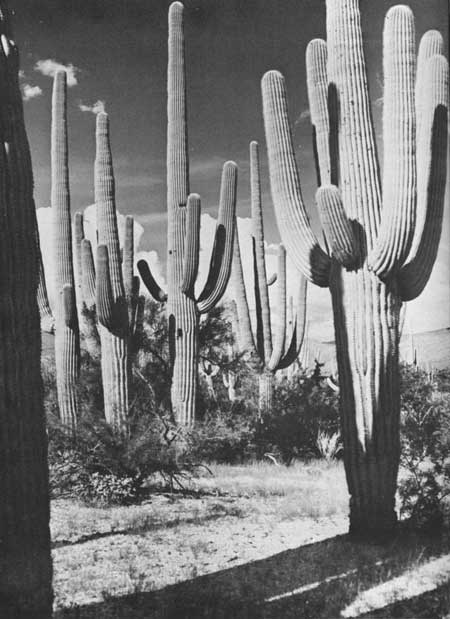|
SAGUARO National Park |
 |
Adaptation of Plants to a Desert Environment (continued)
 The Cactus Forest has been called a wilderness of unreality. |
SUCCULENTS (WATER-STORING PLANTS)
The cactuses are called stem succulents. In many varied forms they dominate the palo verde, bur-sage, and cactus plant association in Saguaro National Monument. In size they range from tiny button and pincushion types, some of which weigh only a few ounces, to the giant saguaro, the bulkiest of which have been estimated at more than 10 tons. All cactuses have developed moisture-retaining tissues in their stems which enable them to store quantities of water during the wet season for use during long periods of drought, thereby equalizing the irregularities of water supply. In the course of evolution the cactus has eliminated its leaves, and their function has been taken over by the green outer covering of the stems. By so doing the amount of transpiration (main source of moisture loss from plants) has been greatly reduced.
Certain other desert plants, principally the yuccas, echevarias, and the agaves, have retained their leaves and have developed additional water-storage tissues in them. A few, notably the NIGHTBLOOMING CEREUS (Peniocereus greggii), have slender stems but an enormous carrot-shaped root in which the moisture-storage tissue is located. The GOURDS (Cucurbita sp.) also have large, thick, moisture-retaining roots, as does the WILD-CUCUMBER (Marah gilensis).
Cactuses are easily recognized, although many people mistakenly believe that any plant with spines or thorns is a cactus. Dr. Forrest Shreve states
Several structural features have served to give the cacti their outstanding appearance, so unlike that of other plants. Most general have been the loss of the leaf as a permanent organ, the enlargement of the stem to accommodate water-storing tissue, and the development of local spine-bearing structures known as "areoles." In several genera, the stem is segmented into sections which are flat and somewhat leaflike; in others the stem is round, much branched, and the surface occupied by close-set tubercles. In a large group, including massive erect forms, as well as slender climbing ones, the stem is grooved or fluted and thus able readily to accommodate its surface to great fluctuations in the water content of the tissues.

|

|
|
|
|
Last Modified: Sat, Nov 4 2006 10:00:00 pm PST |


